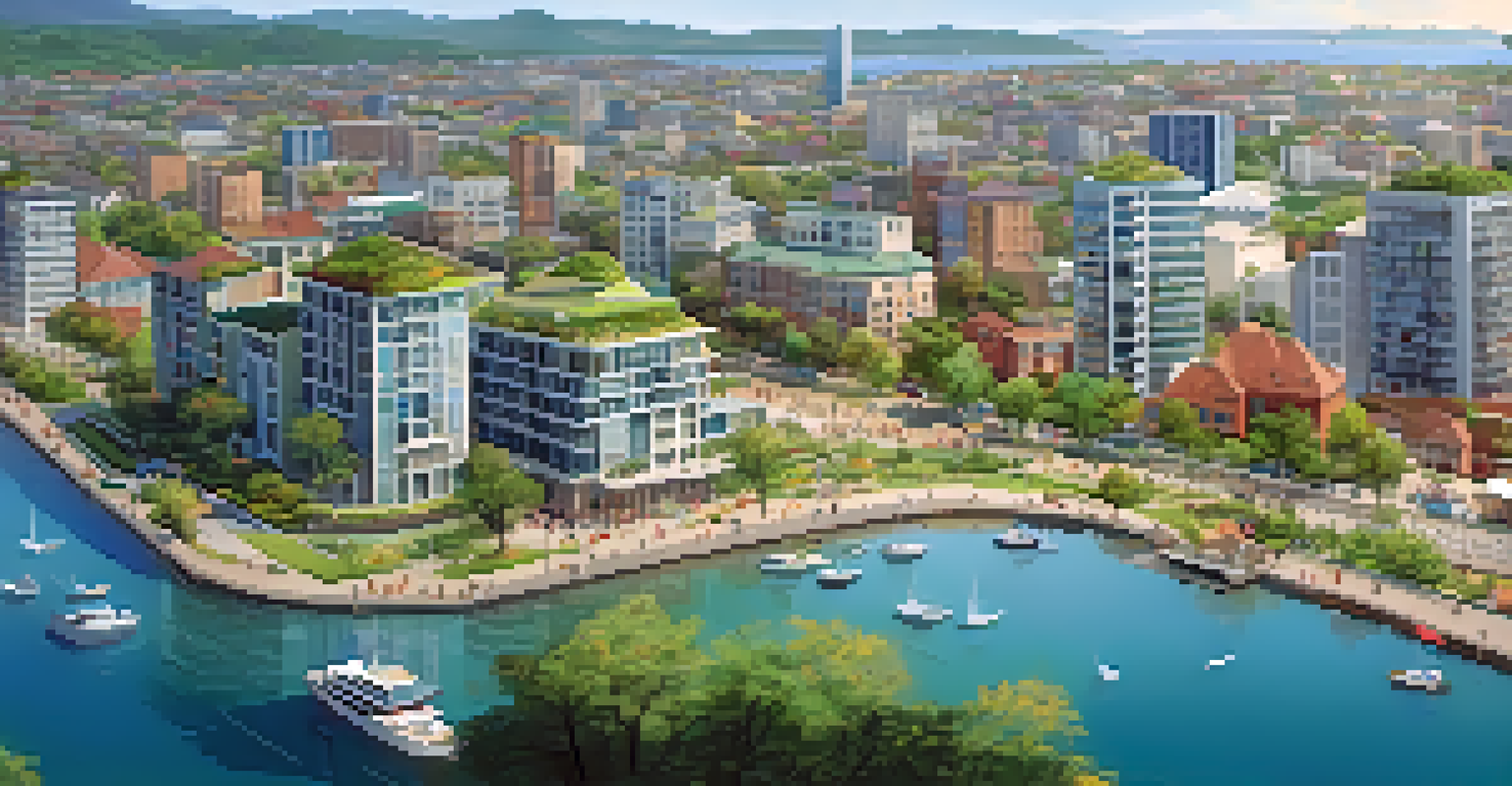Urban Resilience: Strategies for Adapting to Climate Change

Understanding Urban Resilience and Its Importance
Urban resilience refers to a city's ability to absorb, recover, and adapt to climate-related stresses. It's crucial because as cities grow, they face increasing threats from climate change, such as flooding, heatwaves, and sea-level rise. Just like a well-built bridge can withstand strong winds, resilient cities can better handle environmental changes.
Resilience is all about being able to overcome the unexpected. Sustainability is about survival. The goal of resilience is to thrive.
The importance of urban resilience becomes clear when we consider recent natural disasters that have devastated communities. For instance, cities that invested in resilient infrastructure often recovered faster and with less damage compared to those that did not. This highlights that planning for resilience is not just a good idea; it’s essential for survival.
Moreover, urban resilience is not solely about responding to crises; it’s about proactive planning and community engagement. Cities that involve residents in resilience planning often create stronger bonds and a shared sense of responsibility. This collaborative approach can transform how communities tackle climate challenges together.
Assessing Vulnerabilities in Urban Areas
A key step in enhancing urban resilience is assessing the vulnerabilities specific to each city. This involves analyzing factors like geography, infrastructure, population density, and socio-economic status. For example, coastal cities may be more vulnerable to flooding, while urban heat islands can exacerbate heatwaves in densely populated areas.

Understanding these vulnerabilities allows city planners to prioritize resources and efforts effectively. In New Orleans, after Hurricane Katrina, a comprehensive vulnerability assessment led to significant improvements in levee systems and emergency response protocols. This proactive approach not only protects lives but also builds community confidence.
Urban Resilience is Essential
Cities must enhance their resilience to effectively absorb and adapt to climate-related stresses like flooding and heatwaves.
Additionally, involving local communities in vulnerability assessments can yield valuable insights. Residents often have firsthand knowledge of their neighborhoods' challenges, leading to more tailored and effective solutions. This participatory approach fosters ownership and commitment to resilience strategies.
Green Infrastructure: A Nature-Based Solution
Green infrastructure refers to using natural systems to manage stormwater, reduce heat, and enhance urban biodiversity. Think of it as nature’s toolbox for city planning. By integrating parks, green roofs, and permeable pavements, cities can effectively mitigate climate impacts while providing recreational spaces for residents.
We cannot solve our problems with the same thinking we used when we created them.
For example, New York City has implemented green roofs to absorb rainwater and reduce urban heat. These not only help manage stormwater runoff but also improve air quality and provide habitats for wildlife. This dual benefit showcases how green infrastructure can be both practical and aesthetically pleasing.
Moreover, green infrastructure projects often engage communities, creating a sense of pride and ownership. When residents participate in planting trees or maintaining gardens, they build connections to their environment. This engagement not only enhances the ecosystem but also fosters community resilience.
Building Climate-Resilient Infrastructure
Investing in climate-resilient infrastructure is vital for urban areas facing climate change. This means designing buildings, roads, and utilities to withstand extreme weather events and changing conditions. For instance, elevated structures can minimize flood damage in areas prone to rising waters.
Cities like Rotterdam are leading the way by incorporating resilience into their infrastructure projects. The city has built a series of water plazas that can temporarily store excess rainwater during storms, effectively preventing flooding while providing public spaces during dry periods. This innovative approach illustrates the benefits of forward-thinking design.
Community Engagement Matters
Involving residents in resilience planning fosters a sense of ownership and leads to more effective, tailored solutions.
Additionally, retrofitting existing infrastructure to meet new climate challenges is equally important. This can involve upgrading drainage systems or reinforcing bridges. By proactively addressing vulnerabilities, cities can avoid costly repairs and disruptions in the future.
Community Engagement in Resilience Planning
Community engagement is a cornerstone of effective urban resilience strategies. When residents are involved in the planning process, they bring unique perspectives and local knowledge that can enhance solutions. This collaborative approach ensures that resilience strategies are grounded in the realities of everyday life.
For example, in Seattle, community workshops helped shape the city’s climate action plan. By gathering input from diverse groups, the city developed initiatives that addressed specific local needs, such as enhancing green spaces and improving public transportation. This participatory process not only improves outcomes but also fosters a sense of belonging and investment among residents.
Moreover, community-led initiatives can mobilize resources and create a collective response to climate challenges. When neighborhoods come together to plant trees or create community gardens, they not only beautify their surroundings but also build social ties. These connections can be invaluable during times of crisis, as communities that know each other tend to support one another.
Leveraging Technology for Urban Resilience
Technology plays a vital role in enhancing urban resilience by providing data-driven solutions to climate challenges. Smart sensors can monitor environmental conditions, such as air quality and water levels, allowing cities to respond swiftly to emerging threats. For instance, cities can deploy flood alerts based on real-time data to keep residents informed and safe.
Moreover, technology can facilitate better communication during emergencies. Apps and platforms that provide timely updates on weather forecasts, evacuation routes, and resource availability can save lives. This proactive approach ensures that residents are equipped with the information they need to make informed decisions.
Technology Enhances Urban Planning
Leveraging technology and data-driven solutions can significantly improve cities' responses to climate challenges.
Additionally, leveraging technology for urban planning can lead to innovative solutions. Geographic Information Systems (GIS) can analyze data on vulnerabilities and aid in the strategic placement of green infrastructure and resilient buildings. By harnessing technology, cities can build smarter, more adaptive urban environments.
Creating Policies for Sustainable Urban Growth
Effective policies are essential for promoting sustainable urban growth that prioritizes resilience. Policymakers need to establish regulations that encourage green building practices, sustainable transportation, and equitable access to resources. For instance, zoning laws can be adjusted to incentivize the development of green spaces and mixed-use neighborhoods.
Cities like Copenhagen have set ambitious climate goals through comprehensive policies that support sustainable urban development. By integrating climate considerations into all levels of decision-making, they have created a framework that fosters resilience while enhancing quality of life. This holistic approach ensures that growth is both sustainable and inclusive.

Furthermore, collaboration between government, businesses, and communities is crucial for implementing effective policies. Engaging stakeholders in the policy-making process not only increases transparency but also promotes shared responsibility. When everyone has a stake in resilience efforts, cities can create a unified front against climate change.